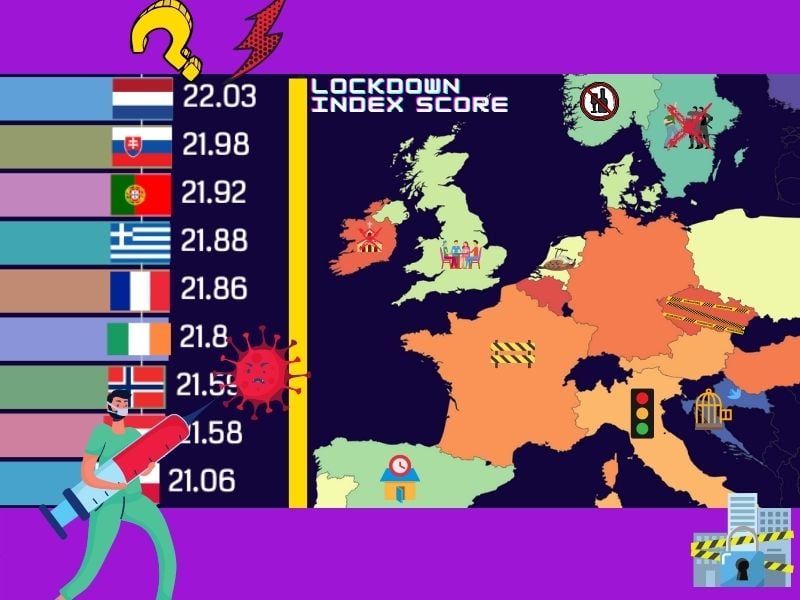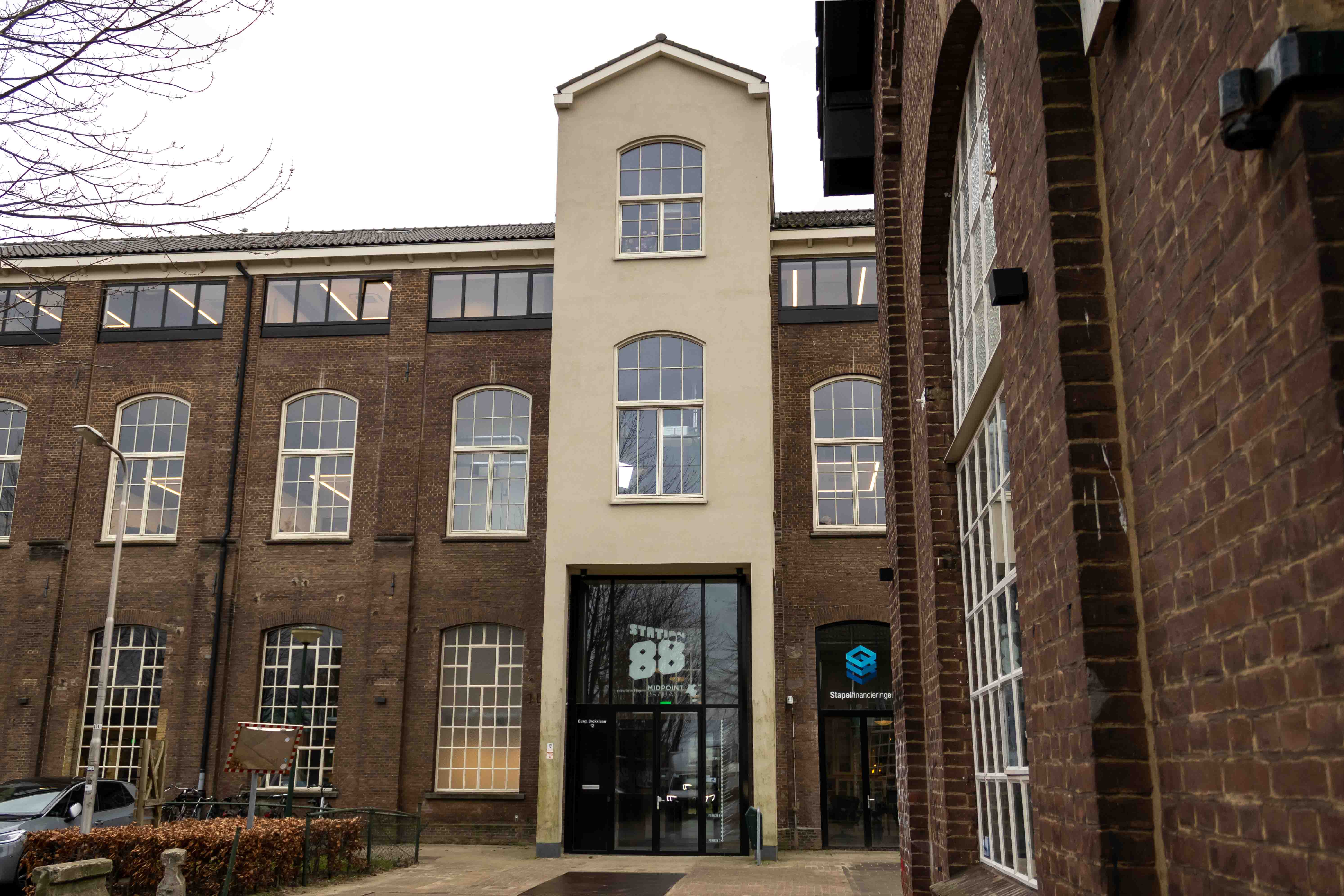
April does what it wants, which is apparently no different during a pandemic. The first 14 days of this month has all been about showing two faces. In some countries, the lockdown will be phased out this month, while other governments will have an extra bag of sand at the gates so as not to drown in the onslaught of viral high tides.
But which countries are they most strict? And which ones are allowed to do the most? The quick answer: Greece and Finland respectively. Exactly how the fork in the road lies is made clear at a glance in this instalment. A new Lockdown Index score compares eighteen countries against each other on 22 measures, restrictions and closures. The overall scores offer an entirely new insight into the differences between them.
The latest interim figures for vaccination percentages are also erratic. Odd one out is the Netherlands, where early this week during a press conference held by Prime Minister Mark Rutte and health minister Hugo de Jonge, 700,000 vaccines were tallied up in one fell swoop. A new estimation method was born. Apparently, the Netherlands had been underestimating the number of vaccines for over a month. Which was why it had fared so poorly on the international lists.
A colossal difference
Below is written: ‘Here is the latest animation of the EK vaccinations updated to and including Wednesday. A new group of pursuers catches up to the lead group at the top after a breakaway from the ever-shrinking pack.
How is the Netherlands doing in the continental jab pecking order? Well, we are not the last.’
From European Championship to World Cup

Fires under control and fire hotspots
In the United Kingdom, the first steps were taken at the beginning of this month to unlock public life. For the first time in 2021, Britons were allowed to have a beer on the outdoor terrace again. A lot of public buildings have reopened too. The acrimonious lockdown they had been in since the beginning of the year, combined with high vaccination rates, have led to an almost completely corona-light society. After Israel, the British now seem to be the second country on earth where ultra-fast jabbing has been the key to getting back to daily life without lockdowns, crowded ICUs or mysophobia (fear of germs).
Not just the Brits either. Even in Portugal, where everyone had to stay home for almost three months, more and more freedoms are being allowed because of the lower number of infections. Still, so far, it is by no means a corona-light spring everywhere. Where the Czech Republic seems to be cooling down a bit at the moment, Sweden, Hungary, Poland and France in particular are experiencing a full-blown viral outbreak. In an effort to prevent this scenario, countries like Germany, Italy and Norway have tightened their existing rules even further.
For the time being, the Netherlands does not want to have to consider more measures. Here – if the figures allow it – outdoor terraces of cafes and rsetaurants should reopen at the end of April. While tens of thousands of people can look forward to experimental events. The heat map below shows the epidemiological distribution over the past eight weeks.
What is a lockdown exactly?
We have become acquainted with the phenomenon of “lockdown” in a fairly unsubtle way since last year. Yet its actual definition remains rather vague. And terms like total, intelligent, smart or partial lockdown also fail to provide much in the way of concrete clarifications. I thought it would be interesting to compare the policies of European countries. But because the site of Reopen.Europa is pretty cluttered and since the Government Stringency Index of the data heroes of Our World in Data has a rather remarkable structure – in that it does not make a distinction between governmental advisories and mandatory requirements, a rather distorted picture tends to emerge.
By combining these two approaches, the data journalist on duty developed a new Lockdown Index Score that is both simple and concrete. With a number ranging from zero for almost complete freedom, to one hundred for a total lockdown, it is immediately apparent how draconian corona policies are across the board. Half of the score is calculated on the basis of public building closures. Where a complete closure scores 4 points (red), and severe restrictions are good for 2 (purple). The blue area means fully open or that some basic rules are in effect.
Bring out the heavy artillery
That governments also have other guidelines and restrictions in their ‘toolbox’ to reduce social mobility so that the pandemic remains under control, should no longer raise very many eyebrows. The heatmap below depicts the second part of the Lockdown Index Score on about eight measures. This takes into account only tough restrictions, which authorities also actively enforce. Governmental advisories, such as those commonly found in Scandinavia, are colored blue.
‘Lighter’ rules such as mandatory (FFP2) face mask requirements and policies on the sale and consumption of alcohol count as much as the public building closures in the top table. Because working-from-home requirements, curfews, and restrictions on home visits represent the greatest encroachment on individual freedom of movement, affect the entire society, and collectively amount to the stereotypical image of a lockdown, these figures count for twice as much in the final rankings. For countries with ever-adapting regional policies, the most commonly occurring situation was used. In Italy, for example, this amounted to code orange.
Celebrating closures, slight openings and freedom
For those who have done the math a bit, the ‘most free’ Europeans no longer come as a surprise. These are to be found (not in Sweden), but in Finland. Here, although lectures at universities are going ahead, a fairly strict testing and ‘bubble’ obligation for students and staff is in place. Although the Finns do have basic rules in terms of group sizes and socially distancing, as is the case elsewhere on the continent. Yet with a Lockdown Index Score of 2, they have the highest level of freedom on the continent. And despite this very lenient government policy, often of an advisory nature, they have managed to keep corona under control for a year now.
Other than shopping by appointment, virtually everything in Greece is closed, prohibited or mandatory. With 94 out of 100 points, this is where total lockdown seems to be most pronounced. Belgium is surprisingly second with 86 points and the third-wave ravaged Czech Republic is number three. For a supple corona policy in a warm vacation resort country, Croatia and Spain currently hold the best credentials.
How totalitarian is the Netherlands? Based on this compound score, it is not that bad. With only 40 out of 100 points, this river delta strip of land ranks among the countries which have considerably more lax policies than most neighboring countries. Despite the fact that relatively many public buildings here are closed. In the Netherlands, only one of the four most severe measures – curfew – is actively enforced. As working from home and visiting restrictions are just advisories, the final score is quite low. The map shows the lockdown index number of all eighteen countries. The fractional scores become visible in the pop-ups per country.
More infections = more restrictions?
Although the European Union has been advocating a continental corona approach from the start, the individual member states continue to be mainly in charge of their own affairs. You would think that in countries with a high Lockdown Index Score, that there would be just as much Covid-19 spreading around. Yet this picture does not seem to be entirely correct. Germany prefers to intervene early, Ireland prefers to wait and Greece likes to play it safe.
The countries on the bottom left enjoy a lot of freedom and relatively few infections, while the top left represents a lot of restrictions and a lot of infections. Based on the median of all eighteen countries, easing restrictions for Ireland seems to be the safest bet. Sweden still exemplifies the laissez-faire policy for which they received considerable praise and a helluva lot of criticism last year – despite their massive incendiary infection rates and soaring death toll. But for how long? For real freedom – and smart policy – it’s better to move one country to the east.
Delicate public support and a prudent perspective perspectief
What exactly is the Netherlands up to in this insane week of new promises, roadmaps to freedom, hassles with two vaccines, increasing pressure in hospitals, colossal corrections to the inoculation figures and a whole series of extremely expensive experimental events that are supposed to attract 10,000 visitors? Not a clue. According to the re-elected Prime Minister Mark Rutte and his cohort Hugo de Jonge as Corona minister, by the end of this month the outdoor terraces can open again and the curfew should be lifted.
The Lockdown Index Figure for the Netherlands will go down by no less than 14 points in 14 days’ time, provided the figures permit it. As in: end of curfew (-8), higher education and universities open (-4), catering establishments open outdoors (-2) and retail trade open (-2) in order to arrive at a lowly lockdown score of 26. Only Croats and Finns currently have such far-reaching freedoms. This weekend, just like every Sunday, there will be another demonstration on the Museumplein against the ‘Police State’ of the Netherlands and the ‘totalitarian lockdown’.

The roadmap to the step-by-step plan
Countries frequently look over each others’ shoulders for new measures or relaxations. For example, the Czech Republic was the first in Europe to introduce a mandatory face mask requirement last year. The plan for a curfew comes from France, and it is explicitly advising – not mandating – basic rules taken from the Scandinavian strategy guidelines. The Dutch government also looked across the border for its roadmap. That is, Portugal and Great Britain, which were still the scene of the continent’s fiercest corona wildfires back in December.
With the help of a gruelling stay-indoors requirement and, in the British case, a well-oiled vaccination strategy, their rates now allow them to dare to dream of a free future. Yet despite the lack of a punishing confinement policy, low infection rates and a well-oiled vaccination strategy, the Netherlands seems to want to follow this route as well. And where exactly did they get the idea of this step-by-step plan from? Watch and judge for yourself. With the British, phase two went into effect this week. While the Portuguese have to sleep another four nights before the fourth of the five phases edges them towards freedom.









